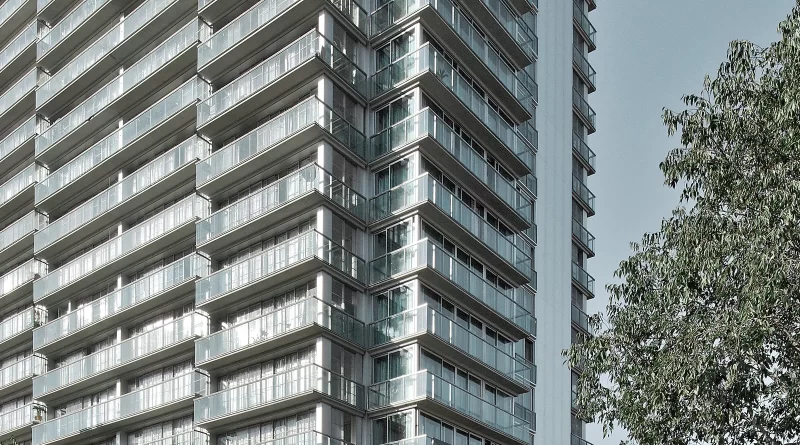Refurbish don’t demolish
London council estate residents should automatically be given the chance to have their say on estate refurbishment versus demolition.
*
“Never demolish,” admonishes Frédéric Druot. “It’s stupid to demolish. Demolition never speaks about the people who live inside.”
Renovators lionize architect Frédéric Druot as a king of ‘retrofit’ – the rescue and reuse of public housing.
But developers tend to prefer to demolish such public housing, denigrating it as obsolete and outmoded. Hence, the demolishers dismiss and even demonize Druot.
*
Never demolish
Druot looks a little refurbished himself, smartly but not sharply garbed, casually clad in a sports jacket and jeans. Speaking in zippy-zappy clipped vowel English, Druot peppers his drole speech with wry irony. He charms a 500-strong audience gathered inside the imposing central London HQ of the Royal Institute of British Architects.
“It is incredible, I know, but in France, people actually live in buildings,” quips Druot with a shrug.
Cue generous applause from the assembled architects. Not a soul seeks to dismantle Druot’s ‘never demolish’ central tenet during the Q&A session that follows his speech. Such reluctance seems surprising – given that a corporate array of architects, developers and politicians are collaborating to demolish more public housing in London than in any other city on Earth.
*
Tour Bois-le-Prêtre
Druot enlightens his RIBA audience about Tour Bois-le-Prêtre, a wholly refurbished 1960s public housing complex in Paris that stands in stark contrast to London council tenants and leaseholders who live in a forest of London council estates now threatened with, or undergoing, developer-led demolition and redevelopment. The transformation by refurbishment story of Tour Bois-le-Prêtre, a 16-storey block in the 17tharrondissement of outskirts Paris, enshrines Druot’s ‘never demolish’ mantra.
Back in the 1960s, the fashionable idea of ‘streets in the sky’, inspired by Le Corbusier, seduces Raymond Lopez, Tour Bois-le-Prêtre’s original architect. Lopez designs 96 apartments inside a 50-metre-high tower. But, for a variety of reasons, including political indifference, Tour Bois-le-Prêtre residents endure their estate’s later decay and neglect during the late 1970s and 80s.
Coloured panels promise to rescue residents from this decay in the 1990s, altering the block’s original façade to improve insulation. But the panels – and the installation of smaller windows – severely reduce natural light entering each apartment. Residents say they begin to feel claustrophobic.
“The little boy and girl could not see out of the window,” says Druot.
*
Inside out
Tour Bois-le-Prêtre again deteriorates further in the late 1990s, falling below 21st century building standards. Residents desperately need the block to undergo repair and modernisation. Some Parisians movers and shakers even call for the entire block to be demolished – a similar knee-jerk reaction like that acted upon by many London urban planners and politicians dithering over the deteriorating physical fabric of the city’s council estates.
But, in 2005, Paris Habitat, the Paris Office for Public Housing, decides to run an architectural competition to renovate Tour Bois-le-Prêtre – on condition that any renovation must not exceed the building’s existing footprint. Frédéric Druot, Anne Lacaton and Jean Philippe Vassal’s winning proposal hinges on, what Druot calls, “working from the inside out”. The idea of ‘inside out’ is to give residents the improvements they crave – more space, greater natural light, better ventilation, and grander views of Paris.
Druot, Lacaton and Vassal’s renovation removes the façade of each apartment and bolts on self-supporting glass-clad balconies. Akin to a conservatory, each ‘winter garden’, measuring 7.5 by 3 metres, gives residents in every apartment a welcome flood of natural light. These ‘bolt-ons’ increase space and warmth and reduce energy costs. The glazed balconies offer residents spectacularly enhanced views of Paris.
The ground floor is also renovated, and two new lifts fitted. Even better, another four apartments are added to the original 96 – but without changing Tour Bois-le-Prêtre’s original structure.
*
Existing residents
The fact that this refurbishment finally costs just €11.2 million generates much comment in France, especially as Tour Bois-le-Prêtre’s demolition and redevelopment would have cost, at least, an estimated €20m.
These cost savings also raise the eyebrows of RIBA’s architectural crowd – and ought to actively interest London councillors and planners. But what really engages people in France is just how closely Druot, Lacaton and Vassal work with Tour Bois-le-Prêtre’s existing residents. Residents stay in the tower block during the refurbishment instead of being temporarily rehoused elsewhere, thanks to the use of prefabricated new elements.
After the renovation completes, life returns to normal, even to the extent that some residents still complain about maintenance issues and security worries. Of course, renovation does not solve persistent problems of poverty and anti-social behaviour in the surrounding neighbourhood. The refurbishment also seems to have taken an inordinately long time to come to fruition; even refurbishment seems it must suffer from the warp that is ‘Housing Time’.
Even so, the overall result is that Druot and colleagues design and deliver a stunning transformation of Tour Bois-le-Prêtre, a building some thought irreparable and condemned by others as ripe for demolition. As Druot explains to his RIBA audience, social housing tenants now enjoy nigh new homes delivered by an innovative ‘inside out’ renovation that “put existing residents first”.
*
Alternative
There’s another measure of the quality of the Druot-Lacaton-Vassal renovation. If a block looking like the made-over Tour Bois-le-Prêtre came on to London’s housing market, up-market real estate agents, speculative overseas property investors and ‘ultra-high net worth individuals’ would be all over it like a profit-seeking rash.
But, more importantly, Tour Bois-le-Prêtre also offers potential as a refurbishment model, an alternative for a plethora of London council estates now facing ‘regeneration’ via costly and socially destructive demolition and redevelopment schemes.
Council estates where tenants and leaseholders still call for refurbishment include Robin Hood Gardens, West Hendon, Grahame Park, Cressingham Gardens, Central Hill, Knight’s Walk, West Kensington and Gibbs Green, Northwold, and King’s Crescent. According to housing activists, those estates represent just the more visible swathes of a forest of some 100 London council estates facing a developer-led demolition and redevelopment model of ‘regeneration’. Many, like the Aylesbury Estate in Southwark, look set to be demolished and replaced with a predominant element of private luxury housing, like Woodberry Down in Hackney.
*
Heygate to Haringey
Others could go the way of the Heygate Estate where developer Lend Lease has demolished over 1,200 council homes, a ‘regeneration’ commanded and sanctioned by New Labour politicians at the helm of Southwark Council. Less than 80 ‘social rent’ homes are being built as a paltry and token replacement for the seismic local loss of public housing at the Heygate.
Many of the Heygate’s 3,000 displaced and dispossessed residents have been dispersed to other parts of Southwark and across London – and some are compelled to live in other parts of the country. International property investors, especially from South Asia, are widely reported to have enjoyed a two-year head start over domestic buyers to buy the new luxury replacement homes. Southwark Council’s New Labour-styled leadership stands accused of selling off public land and selling out residents’ homes so global developer Lend Lease can make profits from international investors. Local people talk of a ‘revolving door’ between people working for Southwark Council and Lend Lease.
Southwark Council leader Peter John describes the fate of the Heygate as ‘regeneration’. Many Southwark residents call it an act of class war, a clear form of ‘social cleansing’.
As for Lend Lease, it now looks to drive a similar regeneration vehicle towards council estates in north London, like Broadwater Farm. Lend Lease hopes to seal a wide-ranging ‘regeneration’ deal with another clan of New Labour-styled politicians in the north London borough of Haringey, sometime soon after the General Election.
*
Tour Bois-le-Robin Hood
Hence, in this highly politicised 2017 moment – post-Brexit and at the height of a fiercely fought General Election campaign – few of these London council estates look likely to be rescued from the developer-led demolition and redevelopment approach to regeneration that dominates London in the 21st century.
These multi-million, and in some cases, multi-billion pound ‘regeneration’ schemes, some hauling themselves through 20 years of phased demolition and construction, threaten existing residents – mainly working Londoners on average and lower incomes – with dispossession of their homes and displacement from their neighbourhoods.
For instance, elected politicians at the London Borough of Tower Hamlets have granted residential developer and housing association Swan Housing consent to demolish 214 homes at Robin Hood Gardens, an estate completed in 1972 and a prime example of Utopian-style Brutalist housing. Many residents want redevelopment but also want to be allowed to return as secure council tenants, rather than as fixed-term housing association tenants on a new development with a vastly increased density of households and a reduced proportion of subsidised ‘social rented’ homes for people in their income bracket.
*
Refurbished
Swan says the overall scheme will see 1,575 homes built over a ten-year phased construction programme. The redevelopment will include 700 ‘affordable homes’ of which 80% will be for ‘social rent’, roughly equivalent in price to a council rent. But tenants worry that these ‘social rents’ might rise to unaffordable levels on the back of fixed and insecure tenancies. The exact price and type of ‘affordable homes’ to be provided also remains shrouded in mystery – fuelling further antipathy to the Orwellian London ‘affordable housing’ concept where many such homes are unaffordable to Londoners on average and lower incomes.
By some accounts, the defeat of a campaign to save Robin Hood Gardens is all over bar the shouting. An attempt to protect Robin Hood Gardens by securing its listed status failed. Richard Rogers, architect of the Pompidou arts centre in Paris, the controversial One Hyde Park, and London Heathrow Terminal 5 – and not renowned as a staunch advocate of council housing – believes that Robin Hood Gardens is of “outstanding architectural quality” that offers “generously sized flats that could be refurbished”.
*
Automatically
Refurbishment, therefore, seems ‘old chapeau’, despite Druot’s ‘never demolish’ refrain – and for some London council estates refurbishment might not always be the best option. But London council estate residents should be given refurbishment options if there is a chance they could succeed – and residents should automatically be given the chance to have their say on refurbishment versus demolition options through estate-wide ballots, a natural exercise and extension of local democracy.
As Druot says: “Of you don’t believe me, look at Tour Bois-le-Prêtre. The little boy and girl can now see out of the window.”
*
© Paul Coleman, London Intelligence. This article first appeared in 2017.



